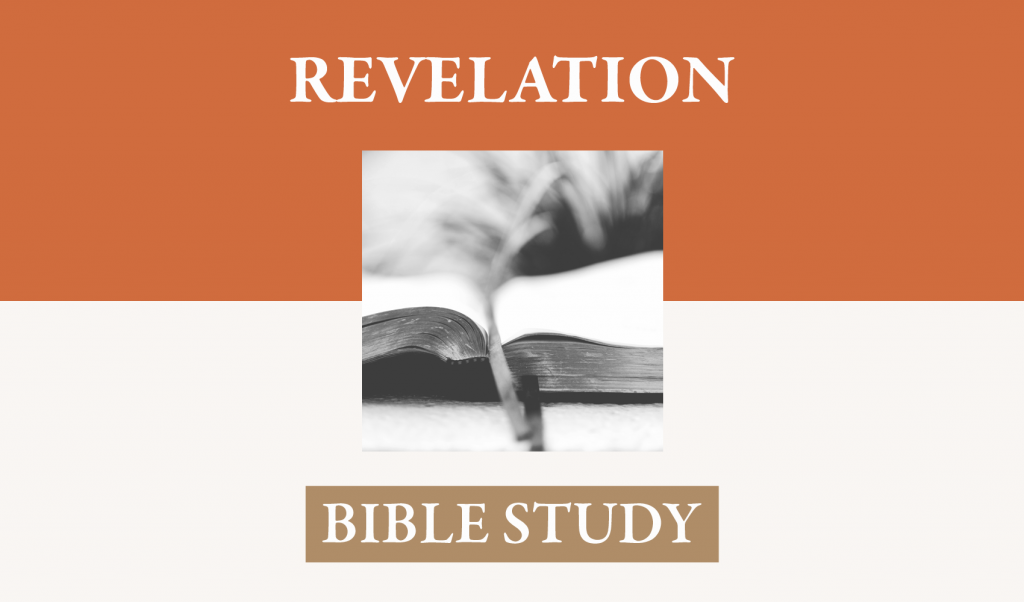“A young but mighty eagle descended rapidly from the sky, and with lightning quickness and indomitable courage inserted his talons into the face of the bulldog, avoiding its gigantic jaws and dropped him into the great river that ran by the haughty city.” Perhaps as an accompaniment to a political cartoon of the late 1780’s (this sentence and scenario is purely contrived on my part) everyone would see this as a symbolic summary of the victory of the newly formed
Among the most dominant symbols in numbers is the number 7. Messages are given to seven churches, there are seven seals on the scroll that the Lamb is worthy to open. The opening of the seventh seal reveals seven angels who each are given one of seven trumpets. Chapter 15 begins a narrative of seven angels with seven plagues. Another feature that we will seek to investigate is the recapitulation of the same event moving from an earthly perspective to a heavenly perspective. Sometimes, it appears, that a vision is an explanatory perspective of an event that has occurred earlier in the revelation. A constant theme, moreover, is how every work of God, in creation, in redemption, in displays of mercy and in displays of wrath, the inhabitants of heaven see its perfect reflection of the wisdom of God and praise him.
Like the gospel of John in verse 1:1-18 and the letter of First John in 1:1-4, the Revelation has a prologue in verses 1:1-8. Also like the gospel, this establishes the conclusion in the beginning, before the evidence is distributed leading to the conclusion.
I. Verses 1-3 – This book, much like the Gospel of John and the letter of First John establishes the eye-witness, revelatory character of the writing.
A. In this case the order of the revelation is from the Father to the Son and then to “his servants.” During his days as Messiah, Jesus told his disciples that “of that hour” he did not know. Now, he does not reveal the hour, but in his completed work as Messiah, the Son takes the sealed book (5:7) and unfolds the flow of history, the divine intention and sovereignty behind it, and the glory of his eternal reign.
B. It is, thus, a revelation from Jesus Christ and preeminently of Jesus Christ. We find that the purpose of creation (4:11), was always bound up in the Father’s love for the Son and to bring glory to Himself through the redemptive work of the Son (5:9, 13). In First John, he recalls his personal sight of Christ in his state of humiliation on earth; in Revelation his vision is of the resurrected, glorified, and reigning Christ. In the Gospel of John, the evangelist consistently unfolds the glory of God as seen in the wisdom, power, and purpose of the incarnation: ‘And the word was made flesh and dwelt among us, (and we beheld his glory, the glory as of the only begotten of the Father, ) full of grace and truth.” (1:14). In each case, John is confident that his report is true and should be received by the churches as revealed truth.
C. “He made it known by sending his angel to his servant John” – Jesus mediated his revelation through an angel (10:9), and sometimes several angels (Chapter 8).
D. John claims that his witness concerns all that “he saw” in the vision given him by Christ. First John begins with an affirmation that his proclamation arises from what he has seen. The Gospel summarizes the confidence of a first-hand witness account by stating “This is the disciple which testifieth of these things, and wrote these things: and we know that his testimony is true.” (21:24)
E. John attached a tri-fold blessing to his writing to be seen as a unified idea.
1. The one who reads it aloud, those who hear, and those who keep what is written. The reason for the blessing has to do with the certainty and urgency of the message – “for the time is near.” For those who hear and keep the implications of this message, there will be an eternity of joy and blessedness in the New Heavens and the New Earth. Those who do not will abide forever under the wrath of the Lamb.
2. Again, he points to the importance of the writing for the perpetuity it gives the message from generation to generation. In verse 11 John was commanded, “Write what you see in a book and send it” to the seven churches. In verse 19 the risen Christ in all his glory tells John, “Write therefore the things that you have seen, those that are and those are to take place after this.” Among the traits of this risen Christ is a mouth from which comes a sharp two-edged sword. The word of the risen Christ is infallible and powerful, bringing conviction and, like his eyes of flaming fire, manifests complete knowledge of all that we are, discerning “the thoughts and intents of the heart” so that no creature is hidden from his sight. (Hebrews 4:12, 13)
.II. Verse 4, 5 – John initiates the report of the revelation with an affirmation of the indivisible operations of the persons of the triune God. It is quite remarkable that this salutation is given to those that are in the “seven churches” (verse 11). The revelation is all embracing—all history, all the world, every person—and his concern is the well being of the churches.
A. The united blessings of grace and peace summarize the whole of God’s loving action toward his redeemed. Grace points to the unmerited character of all that he bestows as well as the divine initiative and effectual power. Peace summarizes the effect of his all his operations in reconciling sinners to God through the death of the Son.
B. The Father’s self-existence and eternality is fundamental to all that unfolds in the visions of this book. The praise that all the inhabitants of heaven and earth are called on to give, the utter sovereignty of his control of all events would be an infinite irrationality and an abominable contradiction of all justice if one who is Father within the godhead were not self-existent and absolutely eternal.
C. The “seven spirits” is a manner of describing the Holy Spirit as one that is the perfect expression in his own being of the attributes of God. The Spirit is not the Father, but all that the Father is as God, the Spirit also is. Were it not so, he could not “search all things, yea, the deep things of God” (1 Corinthians 2:10). This nomenclature of seven spirits occurs also in 3:1; 4:5; 5:6.
D. Jesus Christ – Eternally the Son of God, who gave a constant witness to the uniqueness of his relation to the Father during his earthly ministry, but in his incarnation John attributes to him this threefold standing.
1. The faithful witness
He always spoke the truth and gave a true rendering of the Scripture – Matthew 5:17-20; Luke 24:27, 32, 44-45; John 6:63, 8:45-47
His words always pleased the Father, and were always what he heard from the Father – John 5:19. 20; 8:28, 38
He laid down his life according to the will of his Father – John 5:306:38-40; 10:17, 18
2. The firstborn of the dead – Firstborn, though derived from privileges given to the firstborn son, by extension means the one who is granted authority and the place of preeminence.
He was not the first to be raised from the dead, for prophets did it by the power of God and Jesus did it during his earthly ministry, but the first, because of his resurrection, to disarm completely the lethal force of death as the consequence of sin.
In verse 18 he proclaimed himself as “the living one. I died, and behold I am alive forevermore, and I have the keys of Death and Hades.”
He has authority over death and hades in that he has conquered death by his death. John 5:21, 22, 27-30. “O death, where is thy sting? O grave, where is thy victory? The sting of death is sin; and the strength of sin is the law. But thanks be to God, which giveth us the victory through our Lord Jesus Christ” (1 Corinthians 15:55ff). The substitutionary death of Jesus, in which, in accordance with the just demands of the Law, he bore the wrath due to sin, has removed its sting.
3, The ruler of kings on earth.-
This statement is an assertion of the fulfillment of Psalm 2. “The kings of the earth set themselves . . . against the Lord, and against his anointed. . . . I have set my king upon my holy hill of Zion. . . . Thou shalt break them with a rod of iron; . . . Be wise now therefore, O ye kings; . . . Kiss the Son, lest he be angry.
If this is so, then God’s people need fear nothing that can be plotted by any of the “kings” of the earth. Those that were presently under great duress and tribulation should see it as a manifestation of the rule of Christ until he dashes cruel kings in pieces like a potter’s vessel.
III. Verses 5b-8- In accord with the first words of the book, “the revelation of Jesus Christ,” John summarizes the glory of the final triumph of Christ over all his enemies, the time in which finally he makes “all his enemies his footstool.”
A. Jesus is praised because of the work he has done in saving his people.
1. He is the one loving us. His love was set on us before the foundation of the world (Ephesians 1:4, 5; John 3:16; 17:23; Romans 5:8; 1 John 4:10), and has continued ever since and will continue into eternity (John 17:26) so that truly nothing can separate us from the love of God which is in Christ Jesus our Lord.
2. He has freed us, loosed us, from our sins. This is the consequence of his eternal love for the people given him by the Father and the necessity of their sins being forgiven because of a payment made for them in their stead. Christ has laid down his life for his sheep (John 10:11, 15, 16).
3. He has made us a kingdom, priests to God. He has lifted us from being not a people to the position of being his people, even a “royal priesthood, a holy nation, a peculiar people” (1 Peter 2:9). Those offices that ideally defined the people of Israel by their pure worship and their political unity under a godly king are combined in the redeemed people who find their identity in the Redeemer King, who also served as the ultimately defining prophet (Hebrews 1:1-4).
4. This redemptive work crowns him with glory and dominion as one that has taken such authority and resplendent glory by combining in his person and work the attributes of justice and mercy, truth and grace.
B. He comes in the full glory of his finished work.
1. “With the clouds,” The word “cloud” first appears as a symbol of the merited wrath of God that has been withheld by his covenantal provision – “I do set my bow in the cloud, and it shall be for a token of a covenant between me and the earth. And it shall come to pass, when I bring a cloud over the earth, that the bow shall be seen in the cloud: And I will remember my covenant. . . ,.and the bow shall be in the cloud.” Genesis 9:13-16. God led Israel out of Egypt and through the wilderness in a pillar of cloud (Exodus 13:21, 22); He spoke to the people from a cloud (Exodus 19:9, 16); He gave the Ten Commandments from a cloud that was necessary to hide the brilliance of his glory; (Exodus 24:15-18); God appeared in a cloud upon the mercy seat at the time of sacrifice (Leviticus 16:2, 13); at the mount of transfiguration a cloud covered the company and a voice came out of the cloud (Matthew 17:5); when Jesus ascended to heaven, a cloud received him out of their sight (Acts 1:9); Jesus described his coming in the language we observe here: “And then shall appear the sign of the Son of man in heaven: and then shall all the tribes of the earth mourn, and they shall see the Son of man coming in the clouds of heaven with power and great glory.” (Matthew 24:30). It is into these clouds that show the propitiated wrath of God that Christians shall ascend at the coming of Christ (1 Thessalonians 4:16, 17).
2. In his descent he will be seen by all the peoples of the earth (How this will happen on this sphere, we do not know, but God will make it happen). Both Jew (“those who pierced him’) a well as Gentile (“all the tribes of the earth”) will wail and mourn at the sight of him. This is not a wailing of repentance at this point but of realization of the universal and absolute truth of his claims and of his sovereign prerogative in the full justice of his judgment. It is the scene depicted in chapter 5:12-17.
3. Verse 8 – The eternally self-existent existent one, scorned by the sinful people of earth, ridiculed in his law and also in the redemptive work of his Son, now vindicates Himself in all his glory and might. This is described in breathtaking images and narratives in the chapters that follow.






















